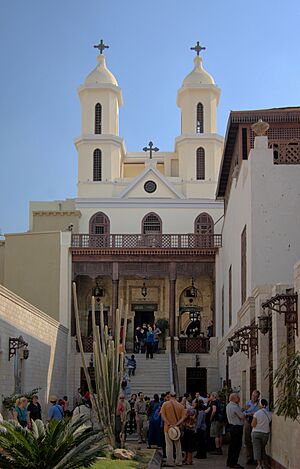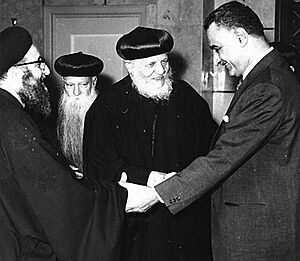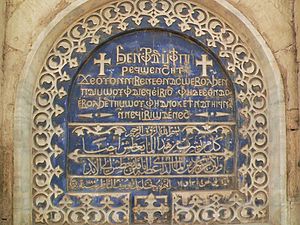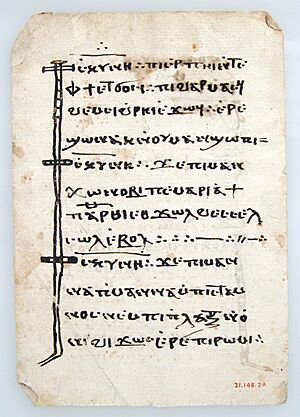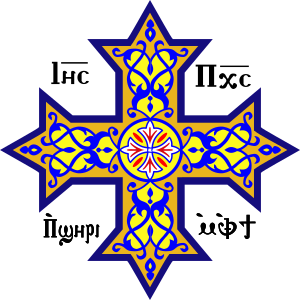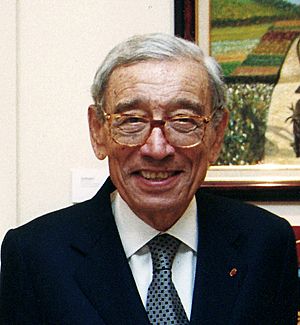Copts facts for kids
| ⲛⲓⲣⲉⲙⲛ̀ⲭⲏⲙⲓ | |
|---|---|
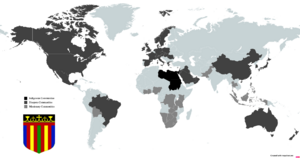
Coptic diaspora
|
|
| Total population | |
| 5–20 million (estimates vary) | |
| Regions with significant populations | |
| Traditional areas of Coptic settlement: | 5–20 million |
| Egypt | 5–20 million (estimates vary) |
| Sudan | <400,000 (2008) |
| Libya | 60,000 |
| Diaspora: | 1–2 million (estimates vary) |
| United States | c. 200,000 – 1 million |
| Canada | c. 200,000 |
| Australia | c. 75,000 (2003) |
| France | c. 45,000 (2017) |
| Italy | c. 30,000 |
| United Kingdom | 25,000 – 30,000 (2006) |
| United Arab Emirates | c. 10,000 |
| Netherlands | c. 10,000 |
| Jordan | 8,000+ (2005) |
| Kenya | 8,000+ |
| Lebanon | 3,000–4,000 (2012) |
| Germany | 3,000 |
| Austria | 2,000 (2001) |
| Switzerland | 1,000 (2004) |
| Israel | 1,000 (2014) |
| Languages | |
|
|
| Religion | |
| Coptic Orthodox Church Greek Orthodox Church of Alexandria Coptic Catholic Church |
|
Copts (Coptic: ⲛⲓⲣⲉⲙⲛ̀ⲭⲏⲙⲓ, romanized: niremənkhēmi; Arabic: الْقِبْط, romanized: al-qibṭ) are a Christian group of people. They originally come from North Africa, mainly Egypt and Sudan. Most Copts are Coptic Oriental Orthodox Christians. They are the largest Christian group in Egypt and the Middle East. They are also the largest Christian group in Sudan and Libya. Copts have historically spoken the Coptic language. This language comes directly from the ancient Egyptian language.
The word Copt first meant all Egyptians. But after Egypt became mostly Muslim in the 7th century, it came to mean native Christians. In Egypt, Copts make up about 5–20 percent of the population. The exact number is not fully known. In Sudan and Libya, Copts are about 1 percent of the population.
After the Muslim conquest of Egypt in 639–646 AD, Coptic Christians faced different treatments. Sometimes they were tolerated, but sometimes they were persecuted. This history of challenges is a big part of the Coptic identity. Most Copts belong to the Coptic Orthodox Church of Alexandria. A smaller group belongs to the Coptic Catholic Church. Some are part of the Evangelical Church of Egypt. Copts played a key role in modernizing Egypt and the Arab world. They also helped with important ideas like democracy.
Coptic Christians speak the same dialects and share culture with other Egyptians. However, they see themselves as different from Arab identity. In Egypt, Copts often have more education and wealth. They are also well-represented in professional jobs. But they have less representation in the military and security. Most health and social facts are similar for Christians and Muslims.
Contents
What Does 'Copt' Mean?
The word Copt came into English in the 1600s. It comes from an Arabic word, qubṭ. This Arabic word came from an ancient Greek word, Aigýptios. This Greek word meant "Egyptian."
The Greek word for Egypt, Aígyptos, came from an even older Egyptian word. This Egyptian word meant "estate of the ka of Ptah." Ptah was an ancient Egyptian god. This name referred to a temple complex in Memphis.
After the Muslim conquest of Egypt in the 7th century, the term Aigýptios started to mean only those Egyptians who were Christian.
Coptic History


Copts are one of the oldest Christian groups in the Middle East. They are part of the larger Egyptian nation. But they have kept their own religious community. They make up about 5 to 20 percent of Egypt's population. Copts are proud that their church was founded by an apostle. The main Coptic Church has been separate from the Roman Catholic Church since the 5th century AD.
How Christianity Began in Egypt
Old stories say that Christianity came to Egypt through Saint Mark. This happened in Alexandria around 42 AD. It was during the time of the Roman emperor Claudius. Saint Mark left a large Christian community in Alexandria.
From Alexandria, Christianity quickly spread across Egypt. We know this from old writings found in Egypt. By the 3rd century AD, most people in Egypt were Christian. The Church of Alexandria became one of the most important Christian centers. It was second only to the Church of Rome. This makes the Church of Alexandria the oldest Christian church in Africa.
Coptic Contributions to Christianity
Copts in Egypt greatly helped shape Christian traditions. The Catechetical School of Alexandria was the oldest school of its kind. It was founded around 190 AD. This school became a key place for religious learning. Scholars like Clement and Origen taught there. The school also taught science, math, and other subjects.
Another big contribution was the start of monasticism. This is a way of life where people live apart from society to focus on religious devotion. Christian monasticism around the world came from the Egyptian example. Important figures included Anthony the Great and Pachomius. By the 5th century, there were many monasteries in the Egyptian desert. People from other places visited these "Desert Fathers" to learn from their spiritual lives.
Early Church Councils
The See of Alexandria played a big role in early Christian beliefs. Egyptian patriarchs led the first three major church councils. The Council of Nicaea (325 AD) was led by St. Alexander. Athanasius, a future patriarch, helped write the Nicene Creed. This creed is still said in many Christian churches today.
The Council of Constantinople (381 AD) was led by Patriarch Timothy. The Council of Ephesus (431 AD) was led by Cyril of Alexandria.
The Council of Chalcedon
In 451 AD, the Church of Alexandria split after the Council of Chalcedon. Those who accepted the council's decisions were called Chalcedonians. Those who did not were called non-Chalcedonians or Miaphysites. Most Egyptians belonged to the Miaphysite group. This led to them being treated poorly by the Byzantines in Egypt.
Arab Conquest of Egypt
In 641 AD, Egypt was conquered by the Arabs. Egyptians resisted this rule for a long time. Egypt stayed mostly Christian for a while. But Coptic Christians lost their majority after the 14th century. This happened because of periods of persecution and destruction of churches. From the Muslim conquest of Egypt onwards, Coptic Christians faced challenges from different Muslim rulers. These challenges included closing churches, forced conversion to Islam, and high taxes for those who did not convert.
Copts in Modern Egypt
Under Muslim rule, Christians paid special taxes. They also had less political power. But they did not have to serve in the military. Their situation got much better in the early 1800s under Muhammad Ali. He removed the special tax and allowed Copts to join the army. Later leaders also helped Copts. They appointed them as judges and gave them political rights. Copts also did well in business.
Some Copts took part in Egypt's fight for independence. They held many important positions. The Coptic Museum was founded in 1910. The Higher Institute of Coptic Studies opened in 1954.
In 1952, Gamal Abdel Nasser led a change in government. He made Egypt a republic. Nasser's policies focused on Arab nationalism and socialism. These policies affected Copts. Permits to build churches were delayed. Christian religious courts were closed.
Coptic Social and Economic Life
In Egypt, Copts often have more education. They also tend to have more wealth. They are well-represented in professional jobs. However, they have limited representation in security agencies. Historically, many Copts worked as accountants. In 1961, Coptic Christians owned a large part of Egyptian banks. A study in 2016 found that about 26% of Egyptian Christians have a university degree.
Copts often belong to the educated middle and upper-middle classes. They have played a major role in managing Egypt's money. Many Coptic business families became very wealthy. For example, the Sawiris family owns the Orascom conglomerate. This company works in many areas like telecommunications and construction. In 2008, their family wealth was estimated at $36 billion. Some scholars believe Copts have higher education and wealth because Coptic Christianity encouraged learning.
Pharaonism
Many Coptic thinkers believe in Pharaonism. This idea says that Coptic culture comes mostly from ancient Egyptian culture. This gives Copts a strong connection to Egypt's long history. Pharaonism was popular among both Coptic and Muslim scholars in the early 1900s. It helped bring these groups closer together.
Coptic Church Affairs
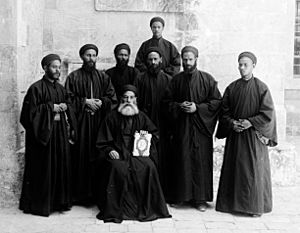
Today, most Egyptian Christians belong to the non-Chalcedonian Coptic Orthodox Church. Other Christian groups also exist in Egypt. These include Protestants and Roman Catholics. The term Coptic usually refers only to native Egyptians.
The previous head of the Coptic Orthodox Church, Pope Shenouda III of Alexandria, passed away in 2012. On November 4, 2012, Bishop Tawadros was chosen as the new pope. His name was picked by a blindfolded boy in a ceremony in Cairo's St Mark's Cathedral.
Copts in Modern Sudan
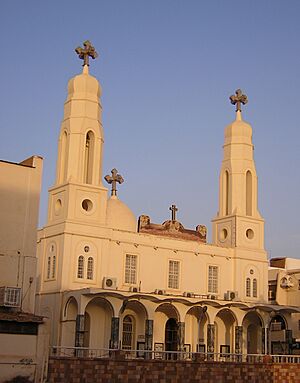
Sudan has a native Coptic minority. Many Copts in Sudan are also descendants of more recent Egyptian immigrants. Copts in Sudan mostly live in northern cities. They number up to 500,000 people. This is a little over 1 percent of Sudan's population. Because they are well-educated, they have played a more important role in the country than their numbers suggest. They have sometimes faced pressure to convert to Islam. This has caused some to leave the country.
Modern immigration of Copts to Sudan grew in the early 1800s. They were generally welcomed. However, they faced a decade of challenges under Mahdist rule in the late 1800s. Many were forced to change their faith. But the Anglo-Egyptian invasion in 1898 gave Copts more religious and economic freedom. They expanded their roles into trading, banking, and medicine. Their skills made them a privileged minority.
However, in the mid-1960s, militant Islam returned. This led to demands for an Islamic constitution. Copts joined others in opposing religious rule. In 1983, Islamic Sharia law was introduced. This started a new period of harsh treatment for Copts. Hundreds of Copts lost their jobs in government.
In 1991, a Coptic pilot was executed for having foreign money. He was offered freedom if he converted to Islam, but he refused. Thousands attended his funeral. This event made many Copts flee the country. Restrictions on Coptic nationality followed. It became hard for them to get Sudanese nationality. This caused problems for travel. Christian schools were taken over. Arabic-Islamic teaching was forced in schools. A Coptic child was whipped for not reciting a Koranic verse.
Today, the Coptic Church in Sudan is officially registered. It does not have to pay property tax. In 2005, a Coptic Orthodox priest was named to a government position.
Copts in Modern Libya
The largest Christian group in Libya is the Coptic Orthodox Church. It has about 60,000 members. The Coptic Church has historical roots in Libya. These roots go back long before Arabs came from Egypt to Libya.
Where Copts Live
Copts live in countries where most people are Muslim. These include Egypt, Sudan, and Libya. The exact number of Copts is often debated. This is sometimes due to religious differences.
It is hard to count the Coptic population in Egypt. Egyptian authorities do not allow researchers to ask about religion in surveys. Official estimates say Copts are 10 to 15 percent of the population. But other sources estimate much higher numbers, up to 25 percent.
The Coptic population in Sudan is about half a million. This is about 1 percent of the Sudanese population.
The Coptic population in Libya is over 60,000. This is also about 1 percent of the Libyan population.
Coptic Communities Around the World

Many Copts live outside of Egypt, Sudan, and Libya. This is called the Coptic diaspora. The largest Coptic communities outside of these areas are in the United States, Canada, and Australia. Census numbers might not be fully correct. Many Copts might list themselves as Egyptian, American, or Canadian instead of Coptic.
The Coptic American population is estimated to be around 200,000. Some Coptic groups say it could be as high as one million. The Coptic Canadian population is estimated at about 50,000. Some groups say it could be up to 200,000. The Coptic Australian population is estimated at about 100,000.
Smaller communities are found in Kuwait, the United Kingdom, France (45,000), and South Africa. Even smaller groups live in Jordan (8,000), Lebanon (3,000–4,000), Germany (3,000), Austria (2,000), and Switzerland (1,000). Copts also live in Denmark, Greece, Italy, the Netherlands, Norway, Russia, and Sweden.
Challenges and Discrimination in Egypt
Religious freedom in Egypt faces some challenges. This is due to government policies that can be unfair. Coptic Christians, as the largest religious minority, are affected. Copts have faced increasing difficulties since 1952. Until recently, Christians needed presidential approval for even small church repairs. This law was eased in 2005. But Copts still face many hurdles in building new churches. These rules do not apply to building mosques.
Coptic communities have been targeted by extreme groups. For example, in 2000–01, there were attacks in El Kosheh. Muslims and Christians clashed after a dispute. Twenty Christians and one Muslim were killed. In February 2001, a new Coptic church and 35 Christian homes were burned.
In 2006, someone attacked three churches in Alexandria. One person was killed. In May 2010, The Wall Street Journal reported more attacks by Muslims against Copts. Police often arrived after the violence. Police also pressured Copts to "reconcile" with attackers. This meant attackers were not prosecuted. No Muslims were convicted for these attacks.
Some Copts have held important government positions. Boutros Boutros-Ghali was Egypt's foreign minister. He later became the Secretary-General of the United Nations. There have also been Coptic ministers and governors. Successful Coptic businessmen include Naguib Sawiris, Nassef Sawiris, and Samih Sawiris. They are among the world's wealthiest people. In 2002, Coptic Christmas (January 7) became an official holiday. However, many Copts still feel they are not well-represented in high-level jobs. They also feel discriminated against in the workplace because of their religion.
The Egyptian constitution guarantees freedom of religion. But according to Human Rights Watch, Muslims who convert to Christianity face difficulties. They struggle to get new identity papers. Some have been arrested for supposedly faking documents. Public officials can make it harder to change religion. Security agencies sometimes say that changing religion could cause social unrest. In 2007, a court denied 45 citizens the right to change their identity papers back to Christian. However, in 2008, a higher court overturned this. It allowed 12 citizens to change their religion on identity cards.
In August 2013, after a change in government, there were widespread attacks on Coptic churches. These attacks were by Sunni Muslims. According to one scholar, these were the worst attacks against the Coptic Church since the 14th century. USA Today reported that "forty churches have been looted and torched." More than 45 churches across Egypt were attacked.
Coptic Language
The Coptic language is the most recent form of the Egyptian language. The term "Coptic" more accurately refers to the writing system. This writing system was used for the Egyptian language from the 1st century AD. Coptic was the spoken language for most Egyptians. It was slowly replaced by Egyptian Arabic by the late 17th century.
Today, Coptic is no longer a spoken language for daily use. But it is still the liturgical language (used in church services) of the Coptic Orthodox Church and the Coptic Catholic Church. It is taught in many schools around the world.
Coptic Calendar
The Coptic calendar is also called the Alexandrian calendar. It is used by the Coptic Orthodox Church. Ethiopia also uses a similar calendar. This calendar is based on the ancient Egyptian calendar. To keep it accurate, a change was made in 25 BC. The Roman Emperor Augustus formally reformed the calendar. This made it match the Julian calendar. This reformed calendar is known as the Coptic calendar. Its years and months are the same as the Ethiopian calendar, but with different names.
The Coptic Year
The Coptic year continues the ancient Egyptian civil year. It still has three seasons, with four months each. Farmers in Egypt still use this calendar. It helps them keep track of the different farming seasons. The Coptic calendar has 13 months. Twelve months have 30 days each. There is an extra month at the end of the year. This month has 5 or 6 days, depending on if it's a leap year.
The year starts on August 29 in the Julian Calendar. Or it starts on August 30 in the year before a Julian Leap Year. The Coptic Leap Year follows the same rules as the Julian Calendar. So the extra month always has six days in the year before a Julian Leap Year.
The Feast of Neyrouz marks the first day of the Coptic year. This celebration falls on the first day of the month of Thout. This is the first month of the Egyptian year. For most years between 1901 and 2098 AD, it falls on September 11. If it's the year before a Gregorian leap year, it's September 12. Coptic years are counted from 284 AD. This was the year Diocletian became Roman Emperor. His rule was known for harsh treatment of Christians, especially in Egypt. So, the Coptic year is shown with the letters A.M. This stands for Anno Martyrum, meaning "Year of the Martyrs."
Genetics and Ancestry
Studies on DNA show that Copts have genetic links to other groups in Northeast Africa. They also have links to people from the Middle East. One study in 2015 found a special genetic component called the Coptic component. This component is strong in Egyptian Copts. Scientists think this points to a common origin for the people of Egypt. They also link the Coptic component to ancient Egyptian ancestry. This is without the later Arabian influence seen in other Egyptians.
Another study in 2017 looked at Egyptians and Copts. It found they had similar genetic makeup. This suggests they share a common history. It also showed that Sudanese Copts have stayed quite separate. They have not mixed much with local Sudanese groups. A 2020 study compared Egyptian Muslims and Christians. It found that they both come from the same ancestors.
Famous Copts
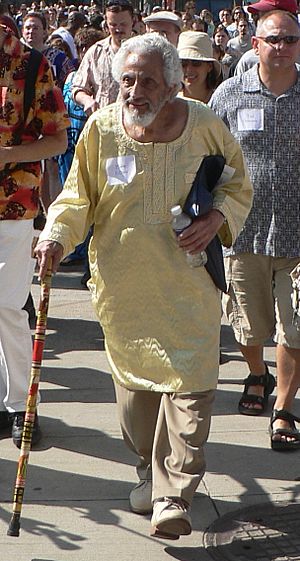
Here are some well-known Copts:
- Hani Azer, a famous civil engineer.
- Halim El-Dabh, an Egyptian-American musician and professor.
- Boutros Boutros-Ghali, the sixth Secretary-General of the United Nations.
- Rami Malek, an Egyptian-American actor.
- Mena Massoud, an Egyptian-Canadian actor.
- Dina Powell, an American politician.
- Fayez Sarofim, a wealthy businessman.
- Naguib Sawiris, the CEO of Orascom.
- Magdi Yacoub, an Egyptian-British heart surgeon.
Images for kids
See also
 In Spanish: Copto para niños
In Spanish: Copto para niños
- Coptic art
- Coptic Catholic Church
- Coptic diaspora
- Coptic identity
- Coptic language
- Coptic Museum
- Coptic Orthodox Church
- List of Coptic saints
- Christianity in Egypt
- Christianity in Sudan
- Christianity in Libya
- List of prominent Copts worldwide


